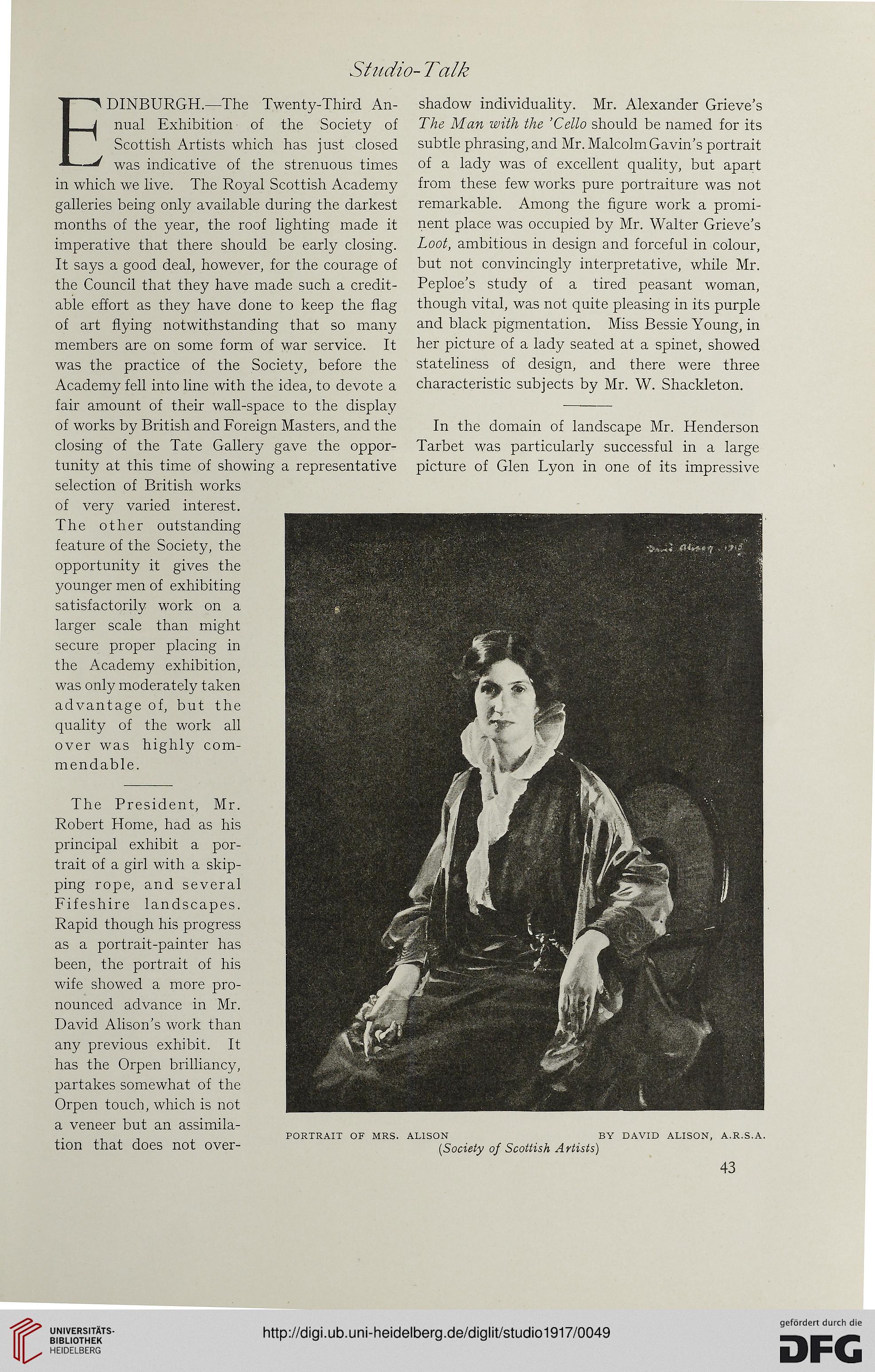Studio- Talk
EDINBURGH.—The Twenty-Third An-
nual Exhibition of the Society of
Scottish Artists which has just closed
was indicative of the strenuous times
in which we live. The Royal Scottish Academy
galleries being only available during the darkest
months of the year, the roof lighting made it
imperative that there should be early closing.
It says a good deal, however, for the courage of
the Council that they have made such a credit-
able effort as they have done to keep the flag
of art flying notwithstanding that so many
members are on some form of war service. It
was the practice of the Society, before the
Academy fell into line with the idea, to devote a
fair amount of their wall-space to the display
of works by British and Foreign Masters, and the
closing of the Tate Gallery gave the oppor-
tunity at this time of showing a representative
selection of British works
of very varied interest.
The other outstanding
feature of the Society, the
opportunity it gives the
younger men of exhibiting
satisfactorily work on a
larger scale than might
secure proper placing in
the Academy exhibition,
was only moderately taken
advantage of, but the
quality of the work all
over was highly com-
mendable.
shadow individuality. Mr. Alexander Grieve’s
The Man with the ’Cello should be named for its
subtle phrasing, and Mr. Malcolm Gavin’s portrait
of a lady was of excellent quality, but apart
from these few works pure portraiture was not
remarkable. Among the figure work a promi-
nent place was occupied by Mr. Walter Grieve’s
Loot, ambitious in design and forceful in colour,
but not convincingly interpretative, while Mr.
Peploe’s study of a tired peasant woman,
though vital, was not quite pleasing in its purple
and black pigmentation. Miss Bessie Young, in
her picture of a lady seated at a spinet, showed
stateliness of design, and there were three
characteristic subjects by Mr. W. Shackleton.
In the domain of landscape Mr. Henderson
Tarbet was particularly successful in a large
picture of Glen Lyon in one of its impressive
The President, Mr.
Robert Home, had as his
principal exhibit a por-
trait of a girl with a skip-
ping rope, and several
Fifeshire landscapes.
Rapid though his progress
as a portrait-painter has
been, the portrait of his
wife showed a more pro-
nounced advance in Mr.
David Alison’s work than
any previous exhibit. It
has the Orpen brilliancy,
partakes somewhat of the
Orpen touch, which is not
a veneer but an assimila-
tion that does not over-
PORTRAIT OF MRS. ALISON BY DAVID ALISON, A.R.S.A.
(.Society of Scottish Artists)
43
EDINBURGH.—The Twenty-Third An-
nual Exhibition of the Society of
Scottish Artists which has just closed
was indicative of the strenuous times
in which we live. The Royal Scottish Academy
galleries being only available during the darkest
months of the year, the roof lighting made it
imperative that there should be early closing.
It says a good deal, however, for the courage of
the Council that they have made such a credit-
able effort as they have done to keep the flag
of art flying notwithstanding that so many
members are on some form of war service. It
was the practice of the Society, before the
Academy fell into line with the idea, to devote a
fair amount of their wall-space to the display
of works by British and Foreign Masters, and the
closing of the Tate Gallery gave the oppor-
tunity at this time of showing a representative
selection of British works
of very varied interest.
The other outstanding
feature of the Society, the
opportunity it gives the
younger men of exhibiting
satisfactorily work on a
larger scale than might
secure proper placing in
the Academy exhibition,
was only moderately taken
advantage of, but the
quality of the work all
over was highly com-
mendable.
shadow individuality. Mr. Alexander Grieve’s
The Man with the ’Cello should be named for its
subtle phrasing, and Mr. Malcolm Gavin’s portrait
of a lady was of excellent quality, but apart
from these few works pure portraiture was not
remarkable. Among the figure work a promi-
nent place was occupied by Mr. Walter Grieve’s
Loot, ambitious in design and forceful in colour,
but not convincingly interpretative, while Mr.
Peploe’s study of a tired peasant woman,
though vital, was not quite pleasing in its purple
and black pigmentation. Miss Bessie Young, in
her picture of a lady seated at a spinet, showed
stateliness of design, and there were three
characteristic subjects by Mr. W. Shackleton.
In the domain of landscape Mr. Henderson
Tarbet was particularly successful in a large
picture of Glen Lyon in one of its impressive
The President, Mr.
Robert Home, had as his
principal exhibit a por-
trait of a girl with a skip-
ping rope, and several
Fifeshire landscapes.
Rapid though his progress
as a portrait-painter has
been, the portrait of his
wife showed a more pro-
nounced advance in Mr.
David Alison’s work than
any previous exhibit. It
has the Orpen brilliancy,
partakes somewhat of the
Orpen touch, which is not
a veneer but an assimila-
tion that does not over-
PORTRAIT OF MRS. ALISON BY DAVID ALISON, A.R.S.A.
(.Society of Scottish Artists)
43




